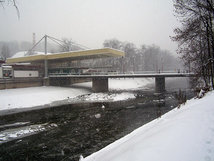Border: Poland-Czech Republic
Date(s) of establishment: Current demarcation in 1975; Official existence in 1993Length of border: 796 km
Regions concerned: Poland – Silesia, Lower Silesia, Opole;
Czech Republic – Liberec, Hradec Králové, Pardubice, Olomouc, Moravia-Silesia
European programme(s):
- "Poland-Czech Republic" operational programme:
The programme on the Inforegio website
Presentation
The current border between Poland and the Czech Republic was formally established on 1 January 1993, following the dissolution of Czechoslovakia. It extends 796 km, starting in the west, in the valley of Zittau at the border tripoint between Germany, the Czech Republic and Poland, crossing the Sudetes mountain range (Jizera Mountains, Giant Mountains, Orlické Mountains, Hrubý Jeseník), then passing near the Czech town of Opava and north of Ostrava. The border then cuts between the twin cities of Cieszyn in Poland and Český Těšín in the Czech Republic to join the tripoint between Poland, the Czech Republic and Slovakia.
History
Marked by the geopolitical developments in Central Europe, the development of the current demarcation of the Polish-Czech border began within the Holy Roman Empire in 1034, between the Kingdom of Bohemia and the Duchy of Silesia. The dissolution of the Empire in 1806 left the border to develop between the Austrian Empire and Prussia, the western part of the border already having stabilised. In 1918, the creation of Czechoslovakia confirmed this demarcation in the west with a then-German territory (Weimar Republic).
The eastern part was, however, marked in early 1919 by conflict between Czechoslovakia and the Second Polish Republic: while the border was, as a whole, easy to determine following a linguistic division of the former Austrian Silesia, the area comprising the city of Cieszyn (mostly German-speaking) remained disputed by the two governments. Poland decided to hold elections to the Sejm in this area, a de facto inclusion of its inhabitants in Polish territory. Czechoslovakia, having objected, sent its army to defend what it considered its territory: the mining town of Karvina and the railway line linking the Czech lands to Slovakia appear thus as geostrategic interests. After a war known in Czech as the "Seven-Day War" at the end of January 1919, a Polish-Czechoslovak treaty was signed on 3 February 1919 in Paris, under pressure from the Triple Entente, placing the disputed territory under international control (435,000 inhabitants).
In July 1920, the Spa Conference allows the definitive partition of Silesia, giving the Czechoslovaks a little more than half of the disputed territory and a third of its population, including Karvina, the coal mines and the railway line, Poland receiving the territories north of this line. A Polish minority found itself inside Czechoslovakia (Zaolzie region). Lastly, Czechoslovakia also made claims, which were not met, to the areas of Kladské and Raciborz where Czech-speakers were living.
The Czechoslovak region of Zaolzie, home to a Polish minority, was a subject of conflict between Poland and Czechoslovakia from 1938 to 1945. In 1938, Poland annexed this territory, which was validated by the Munich Agreement. In 1939, with the invasion of Poland, Zaolzie became part of Nazi Germany. In 1945, the borders of 1920 concerning this area were restored, but the claims continued. The question was finally settled when the two countries signed a treaty on 13 June 1958 in Warsaw, confirming the demarcation.
After 1945, Poland lost territories in the east, but annexed part of East Prussia, Pomerania and Silesia: the boundary line remained the same, but the border tripoint between Germany, Poland and Czechoslovakia moved to the west, reaching the position it still occupies today, northwest of Hradek nad Nisou (Czech Republic).
After 1945, the Polish-Czechoslovak border underwent only slight modifications. In 1958, the village of Mýtiny in the Giant Mountains became Czechoslovak, joining the municipality of Harrachov. In 1975, following two agreements signed between the countries, the border around Woikowa (Poland) shifted 0.25 km2 to adopt its current position.
On 1 January 1993, the dissolution of the Czech and Slovak Federal Republic set the current border with the Czech Republic on the last changes of 1975, with the qualification that the border with this state had formally existed since 1 January 1969, when Czechoslovakia became a federation of two republics, Czech and Slovak.
Cross-border cooperation
Heavily affected by the restructuring of heavy industry, widely present in the region, the Czech-Polish cross-border area does not yet display a striking level of competitiveness, despite a cross-border cooperation agreement signed in November 1993 by the Polish and Czech Ministries of the Economy. As a consequence, the cooperation programme aims to remove obstacles to the integration of the region within Europe, from an economic and social perspective. The programme also seeks to increase the attractiveness of the cross-border region, for both local and foreign investors, but also for its inhabitants and visitors.
Therefore several initiatives are regularly implemented along the border such as the "Polish-Czech Friendship Days" in the city of Ladek-Zdroj (Poland) or the "Cultural Festivities of Upper Silesia." In the Czech Republic, local authorities are active in many joint tourism events, including the Filipov International Pilgrimage, which brings together Germans, Poles and Czechs.
Territory projects and institutional bodies for cooperation
Cross-border cooperation at the regional level
Eurorégion Neisse-Nisa-NysaEurorégion Beskidy
Groupe de Visegrad


